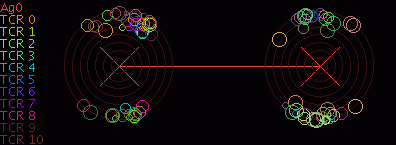

I have created a model of the cytotoxic T lymphocyte (CTL) response to antigen and the maintenance of immunological memory. Because immune responses often begin with small numbers of cells and there is great variation among individual immune systems, I have chosen to implement an individual-based model that captures the life cycle of T cells more faithfully than continuous models. The process of building the model situates the experimental data in a coherent framework that forms a relatively complete and consistent interpretation of CTL response and memory formation on a cellular level. The model should provide insights into the effect infections have on the CTL repertoire and the response to subsequent infections.
A simulation of the human immune system could help us understand disease pathology and facilitate the development of treatment strategies, such as vaccine design and immunotherapy. The in machina experimental approach allows one to perform large numbers of perfectly controlled and reproducible experiments without costly animal (or human) testing. The major barriers to accurate simulation are the lack of accurate empirical data on immune mechanisms and the limits of computational power. The simulation could be used to study diseases of great public interest such as AIDS, hepatitis C, flu, and cancer.
For more information, see:If you are interested in downloading the simulation, click here.
back...